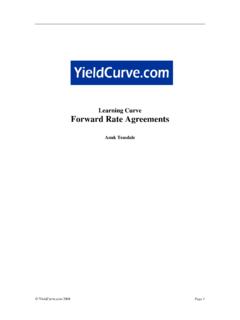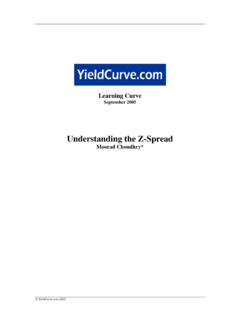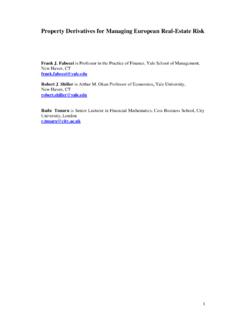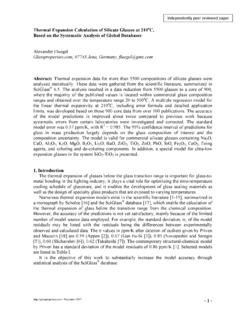Transcription of Total Return Swaps: Credit Derivatives and …
1 Learning Curve Total Return swaps : Credit Derivatives and Synthetic Funding Instruments Moorad Choudhry 2004 Page 1 A Total Return swap (TRS), sometimes known as a Total rate of Return swap or TR swap, is an agreement between two parties that exchanges the Total Return from a financial asset between them. This is designed to transfer the Credit risk from one party to the other. It is one of the principal instruments used by banks and other financial instruments to manage their Credit risk exposure, and as such is a Credit derivative. They are used as Credit risk management tools, and also as synthetic repo instruments for funding purposes.
2 One definition of a TRS is given in Francis etal. (1999), which states that a TRS is a swap agreement in which the Total Return of a bank loan or Credit -sensitive security is exchanged for some other cash flow, usually tied to Libor or some other loan or Credit -sensitive security. The TRS trade itself can be to any maturity term that is, it need not match the maturity of the underlying (or reference) security. In a TRS, the Total Return from the underlying asset is paid over to the counterparty in Return for a fixed or floating cash flow. This makes it slightly different to other Credit Derivatives such as Credit default swaps , as the payments between counterparties to a TRS are connected to changes in the market value of the underlying asset, as well as changes resulting from the occurrence of a Credit event.
3 So, in other words, TRS cash flows are not solely linked to the occurrence of a Credit event; in a TRS the interest-rate risk is also transferred. The transaction enables the complete cash flows of a bond to be received without the recipient actually buying the bond, which makes it a synthetic bond product and therefore a Credit derivative. An investor may wish to receive such cash flows synthetically for tax, accounting, regulatory capital, external audit or legal reasons. On the other hand, it may be easier to source the reference asset synthetically via the TRS than in the cash market. This happens sometimes with illiquid bonds. In some versions of a TRS the actual underlying asset is actually sold to the counterparty, with a corresponding swap transaction agreed alongside; in other versions there is no physical change of ownership of the underlying asset.
4 The first would make TRS akin to a synthetic repo transaction. Figure 1 illustrates a generic TR swap. The two counterparties are labelled as banks, but the party termed Bank A can be another financial institution, including cash-rich fixed-income portfolio managers such as insurance companies and hedge funds. In the figure, Bank A has contracted to pay the Total Return on a specified reference asset, while simultaneously receiving a Libor-based Return from Bank B. The reference or underlying asset can be a bank loan such as a corporate loan or a sovereign or corporate bond. The Total Return payments from Bank A include the interest payments on the underlying loan, as well as any appreciation in the market value of the asset.
5 Bank B will pay the Libor-based Return ; it will also pay any difference if there is any fall in the price of the asset. The economic effect is as if Bank B owned the underlying asset, as such TR swaps are synthetic loans or securities. A significant feature is that Bank A will usually hold the underlying asset on its balance sheet, so that if this asset was originally on Bank B s balance sheet, this is a means by which the latter can have the asset removed from its balance sheet for the term of the TR swap. If we assume Bank A has access to Libor funding, it will receive a spread on this from Bank B. Under the terms of the swap, Bank B will pay the difference between the initial market value and any depreciation, so it is sometimes termed the guarantor while Bank A is the beneficiary.
6 2004 Page 2 Bank A Bank BTotal Return payer or "Beneficiary" Total Return receiver or "Guarantor" Total Return (interest and appreciation)Libor + spread, plus depreciationCash flowBank ABank BUnderlying asset Figure 1: Total Return swap The Total Return on the underlying asset is the interest payments and any change in the market value if there is capital appreciation. The value of an appreciation may be cash-settled, or alternatively there may be physical delivery of the reference asset on maturity of the swap, in Return for a payment of the initial asset value by the Total Return receiver . The maturity of the TR swap need not be identical to that of the reference asset, and in fact it is rare for it to be so.
7 The swap element of the trade will usually pay on a quarterly or semi-annual basis, with the underlying asset being re-valued or marked-to-market on the re-fixing dates. The asset price is usually obtained from an independent third-party source, such as Bloomberg or Reuters, or as the average of a range of market quotes. If the obligor of the reference asset defaults, the swap may be terminated immediately with a net present value payment changing hands according to what this value is, or it may be continued with each party making appreciation or depreciation payments as appropriate. This second option is only available if there is a market for the asset, which is unlikely in the case of a bank loan.
8 If the swap is terminated, each counterparty will be liable to the other for accrued interest plus any appreciation or depreciation of the asset. Commonly under the terms of the trade, the guarantor bank has the option to purchase the underlying asset from the beneficiary bank, and then deal directly with the loan defaulter. The TRS can also be traded as a funded Credit derivative, and this is the case when it is entered into for funding purposes, rather like a repo transaction. Banks have employed a number of methods to price Credit Derivatives and TR swaps . Essentially, the pricing of Credit Derivatives is linked to that of other instruments; however, the main difference between Credit Derivatives and other off-balance sheet products such as equity, currency or bond Derivatives is that the latter can be priced and hedged with reference to the underlying asset, which can be problematic when applied to Credit Derivatives .
9 Credit products pricing uses statistical data on likelihood of default, probability of payout, level of risk tolerance and a pricing model. With a TR swap, the basic concept is that one party funds an underlying asset and transfers the Total Return of the asset to another party in Return for a (usually) floating Return that is a spread to Libor. This spread is a function of: 2004 Page 3 the Credit rating of the swap counterparty; the amount and value of the reference asset; the Credit quality of the reference asset; the funding costs of the beneficiary bank; any required profit margin; the capital charge associated with the TR swap. The TR swap counterparties must consider a number of risk factors associated with the transaction, which include: the probability that the TR beneficiary may default while the reference asset has declined in value; the reference asset obligor defaults, followed by default of the TR swap receiver before payment of the depreciation 1has been made to the payer or provider.
10 The first risk measure is a function of the probability of default by the TR swap receiver and the market volatility of the reference asset, while the second risk is related to the joint probability of default of both factors, as well as the recovery probability of the asset. Example: The TRS as a funding instrument TRS contracts are used in a variety of applications by banks, other financial institutions and corporates. As we noted in the main body of the text, they can be written as pure exchanges of cash flow differences rather like an interest-rate swap or the reference asset can be actually transferred to the Total Return payer, which would then make the TRS akin to a synthetic repo We describe here the use of TRS as a funding instrument, in other words as a substitute for a repo Consider a financial institution such as a regulated broker-dealer that has a portfolio of assets on its balance sheet that it needs to obtain funding for.












